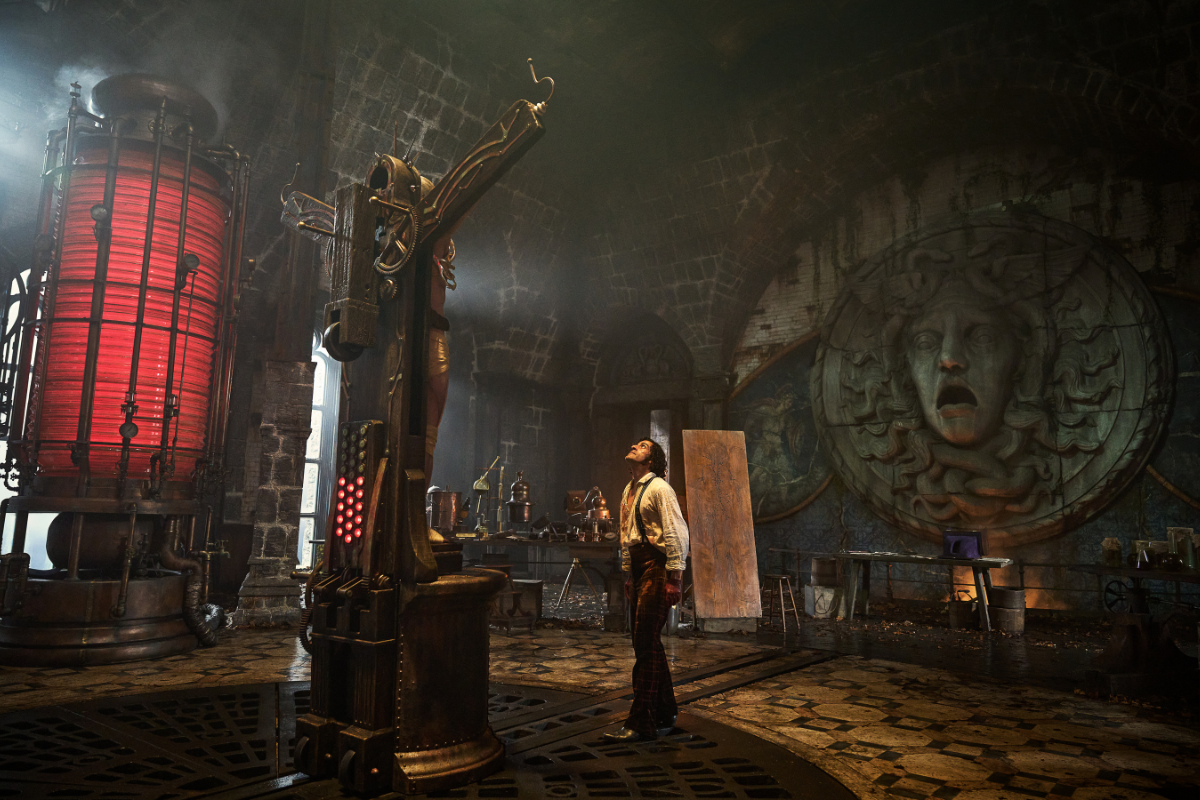CRAFT: Power Revision
There’s a method for redrafting, and it is based upon sound dramatic principles. Otherwise known as the power revision…
ROBERT E. BYRD is Adjunct Associate Professor of Theatre at New York University, Assistant Professor of Communications at St. Francis College in Brooklyn, N.Y., and a faculty member of Gotham Writers Workshops. He has worked professionally in both show business and journalism.
A novelist once confessed to me that he wrote his first drafts whispering “Genius! Genius!” Then, as he watched his printer extrude the last page, he was confident that the entire novel—this time—had spilled out perfectly and would need no revision. A day or two later, he would read the draft and want to shoot himself.
If your first-draft screenplays don’t lay you out like this, you are a rare scriptwright. If you’re like most of us who aren’t so lucky, there’s hope nonetheless: you don’t have to toss out your first effort and start over, nor do you have to slog through the script trying to fix everything on every page. There’s a method for redrafting, and it is based upon sound dramatic principles. Otherwise known as the power revision... Some of those principles we can learn from actors.
People who act in TV commercials have sharply limited rehearsal time. They arrive at the studio, pick up the script, and have maybe 15 minutes to prepare. They can tell you that simply trying to do the whole thing right 50 times—and then repeating the best rehearsal in front of the camera—is the exit ramp to Starvation Boulevard. Rehearsal is most efficient if done in layers, i.e., each rehearsal is focused on only one issue. On one pass, the actor will work on the mechanics of phrasing the lines. On another pass, he will develop the proper way of handling the product, and so on. When showtime comes, he goes on camera, relaxes, and lets the commercial come out any way it wants. He knows he will have the right phrasing, gestures, etc. because he has rehearsed them. But by relaxing into the moment and discovering his performance as he goes along, he gives his work that much-sought freshness of “the first time.”
Applying the same principle, we can turn redrafting into a series of passes through our scripts, addressing only one issue or a few related issues on each pass. By solving the most important problems first, we can save ourselves wasted time on details when the real problems of the script are fundamental. By working in layers, we are charging our subconscious minds so the mystical stuff can happen later.
Deep Structure
At the first level of concern is the bedrock of the script, or rather its mainspring: the dramatic question that holds the audience in the theater. These mainsprings are as crude and necessary as digestion. In Fargo, which is about so many issues, the mainspring dramatic question is no more than “Will Jerry get money from Wade?” In Rocky, it is “Will Rocky defeat Apollo Creed?” If your script has no such propulsive force, no amount of scene polishing will make it hold an audience. If you hesitate to use a crude dramatic question—from fear of writing a simple-minded script—remember that the dramatic question of Hamlet itself is “Will Hamlet kill Claudius?” Or recall what C. S. Lewis said: “There is no high thing without a low thing.”
The next issue is related. Have you chosen the right protagonist? The protagonist must be active: the human force in the main plot. Remember the joke: “There are three kinds of people—those who make things happen, those to whom things happen, and those who say, ‘What happened?’” Your major character must be the first kind of person.
Among the fundamentals, I would include the major structural elements. If you are following three-act form, you will need to check your first and third acts to see if those acts have unity. Act One must be a chain of events leading from the catalyst to the act-ending crucial event. Act Three must be a chain from the climax of the story to the final resolution. “Catalyst” means the story event that breaks the status quo and gets the main plot moving. The act-ending event is the event that throws the main character’s life seriously out of balance and thereby raises the dramatic question of the whole piece. (Ensure that event is indeed strong enough to unsettle everything.) The climax is the event that puts characters on the road heading to the answer to the dramatic question. The final resolution is the scene that provides that answer. The relationship between the dramatic question and these crucial plot points underscores the importance of the mainspring.
Be especially vigilant in policing your first act. Be sure you have not attempted to do too much in the 20 or so minutes you have available. You should try to get the reader oriented and connected to the main character.
Subplots
In Act Two, the major character struggles to put life back in balance, providing unity. However, Act Two is more about amplitude than unity: subplots blossom in the act. Your next pass through your script should focus on subplots.
First, check whether your subplots are bridges to nowhere. Each should have three acts, its own dramatic question, and should reach a resolution. The turning points of the subplots should punctuate the main plot, especially in the long stretches of Act Two. Each subplot should have a definable purpose: to provide additional insight into the main character, to reflect the main plot, to contrast the main plot. Don’t be alarmed if a subplot dominates the script. As long as your main character is active in that subplot, you are not astray.
The Rachel subplot of Witness takes the most screen time of the subplots and is the most memorable. The cops-and-robbers main plot provides the frame for everything else and keeps the tension in the story but isn’t truly focused on except in Act Three.
Characters
Each character in the script, apart from walk-ons, should shed light on the major character. We know about Rocky’s tenderness through his relations with his girl friend, Adrian; we know about his patience through his dealings with Adrian’s brother; we know about his loyalty through his forgiveness of Mickey. In the end, we discover his greatness of spirit through Apollo Creed.
Creed also serves as an echo of Rocky. Rocky’s problem, as we find out in the first scene, is that he is not fulfilling his potential; he is on the verge of becoming a bum. Creed’s problem is that he is so naturally talented that boxing comes easily to him. He takes victory for granted. Only Rockydrives him to his limit and forces him to find and give his best. Rocky saves Apollo from being a certain type of bum as Apollo saves Rocky from being another.
In examining any of our characters, we are more likely to miscalculate their effectiveness if we commit one form of the pathetic fallacy: see and judge them as we see and judge people. Our characters are not living beings; they are forces in a story, simpler and more knowable than real people ever are. Revision is a good time to blink away any film of fallacy that is coating our eyes and to judge our characters professionally. If there is a character with whom you have fallen in love but who serves no narrative purpose, it may be time for a sweeping rewrite or even an extraction. Be sure your supporting characters are not there as straw men to fall over when your protagonist conflicts with them. If your protagonist is wittier, stronger, smarter, better looking and generally superior to everyone, make sure he/she is not roughly the same age and type as yourself. There may be some wish-fulfillment going on. If so, readers of the script will be able to detect it.
Remember to keep your supporting characters in supporting roles. If the foreground of your story is too populous, you are confusing the audience and losing focus. The motion picture is a short form, and the audience has no time to care about more than one or two characters.
Scene Structure
Now is the time to see if your scenes are as tight and necessary as possible. Don’t underestimate your audience by dwelling on the setup of a scene. Usually you can cut to the heart of the matter, and they will catch up with you. Leaving the scene a beat early can create forward movement. For example, in the last moments of the first act of Fargo, the kidnapped wife rolls down a staircase with a shower curtain over her head. One of the kidnappers nudges her, but she lies still. End of scene and act. The audience is left to wonder if the woman is alive or dead.
Consider your scenes one at a time. Does each scene create a change and also raise questions in the audience’s mind? If the scene accomplishes neither of these necessities, you have to consider cutting it. This rule doesn’t always hold for comedy in which some scenes are only for fun, but it certainly applies to serious works. If you have a scene that doesn’t move the plot but seems crucial on other grounds, the solution is often to combine it with one or more adjacent scenes. You will be surprised how frequently this ploy solves the problem.
Every scene should also contain a surprise, not necessarily a big one. Something in the scene should be unexpected. As the Renaissance playwright Lope de Vega put it, “Always cheat expectation.”
Also, make certain that each scene has subtext, i.e., that it is about more than what appears on the surface. You may find it easier to create subtext in the later pages of a script,but subtext should be there all along.
Finally, determine if visual elements are working for you in each scene.
Visuals
Look through your script to see if there are any recurrent visuals. These visuals can be enhanced to create what some call “symbol systems.” An example would be the fires in Firelight.
Look at your three acts. Each should have its own dominant visuals. Remember Gone with the Wind? The first act shows rural wealth, the second act shows poverty and the third act shows urban wealth. Another good example is the film Witness. The first act shows the city, the second act shows the country and the third act shows the city invading the country.
See if any dialogue scenes can be replaced with scenes that are heavily or entirely visual. In Rocky, Rocky does not announce that he is in shape for the fight. Instead, we see him race up a flight of steps and raise his arms in victory.
Make sure that successive scenes do not have the same “look.” Interior/exterior, light/dark, etc., should alternate.
If your story has epic scope, you will want grand images such as the railyard in Gone with the Wind, and silent sequences such as the chariot race in Ben-Hur. Visual images also lend power to more modest stories such as Working Girl. Notice director Mike Nichols’ opening and closing images in that film. Or simply study the silent sequences in his masterpiece, The Graduate.
Dialogue
Dialogue is your last concern and overlaps your work on visuals. Go through your script and, as much as possible, replace dialogue with visuals. If you cannot do this, you may have written a stageplay rather than a movie script. Be sure you haven’t given your actors words where gestures can substitute for speech. If one of your characters says, “I don’t know,” the line can be cut. Why? Because the actor can communicate that thought with a shrug.
Feel free to write sentence fragments in your dialogue. Short words are best, and “old words,” to quote Winston Churchill, “are the best of all.”
Use visual terms. Rather than “They fired me today and weren’t too nice about it,” write, “I had to hand over my office key, and they put a guard over me as I cleaned out my desk.” To see how a brilliant playwright writes for the eye, read Edward Albee’s The Zoo Story. It is a play, not a movie, and the speeches run long; yet Albee’s painting of pictures in dialogue is masterly.
As much as possible, make each line of dialogue have the audience wondering about the answer. If the audience can correctly predict the answer, you are not doing your job. For instance, if Character A says, “How are you?” and Character B says, “You’re the last person who should ask that,” the answer of B is not only unexpected but also makes the audience wonder what Character A will say in return.
Avoid dialogue that stops a scene, such as “I’m not going to talk about it,” or flat answers. There are exceptions—some of them remarkable—but non-communicative answers are usually dialogue drags.
Your speeches should be only a sentence or two; actors should be able to say them in one breath.
Dialogue, like scenes, works best when it is about subtext. Watch The Wings of the Dove with Helena Bonham-Carter and note how the characters send messages counter to what is spoken.
Magic Time
After finishing your dialogue pass, you should lay the script aside for at least five days. Then read it through. Are you aware of the author’s writing style? If the answer is yes, you need to rework your script to make it as literarily neutral as you can. Your screenplay should be transparent: as you read it, you should see a movie in your head, unaware of the words on the page. If your story is not strong enough to hold its own without literary flourishes— which don’t help anyway—then it is not ready for submission, perhaps not yet a screenplay. As you see the movie in your mind, you may find that new insights come to you. Write these down and keep reading.
Now is the time when you discover hidden themes that you can enhance and character touches you would not have thought of earlier.
Put this new material in and then prepare the script for mailing. Now is the time for outside help.
A Fresh Viewpoint
Nothing could be more helpful at this point than a reading by a qualified script analyst. Nothing could be more harmful than a reading by an amateur. So, avoid your friends, financial advisors, lovers, bookies, and especially relatives and psychotherapists, and hire an industry professional. A real pro can spot problems that you can’t see and will make passing remarks that turn into revelations.
Having read the script analysis you’ve paid for, do a touch-up draft. Lay the thing aside for a week and then read it one more time. Make your changes, then work on selling the script. Then go on to write your next screenplay. Often, working on another script gives you ideas about earlier ones. If these ideas are good, go back and work them in. But don’t get stuck redoing any script over and over for years. You are a better writer now than when you started on any earlier script, and your fresh powers reach for fresh material.
The Layered Career
Let me close with a cautionary tale. A dear friend of mine decided he wanted to write a best-selling novel. He started the project, got hooked and spent the last 12 years of his life working on it. The novel got worse and worse. Meanwhile, the best thing he ever wrote lay on a shelf, unfinished. The would-be bestseller was in trouble from the beginning because the author was writing it cynically, for the market instead of himself. Also, the novel had deep problems of concept and structure. He wasted the last years of a valuable life trying to “fix” it by tinkering with details.
Don’t let this happen to you. Often, as you are writing one screenplay, ideas will come to you for another. Don’t stop the work at hand for that new idea but make notes about that next script and keep them near. Then, after you’ve done a reasonable number of layered revisions on your script, quit writing and start selling—and go on to your next project. If the first script sells, producers will pay you to write another draft and tell you how to write that script. Or they will give the script to someone else for a redraft. If you regard each script as one of Now is the time when you discover hidden themes that you can enhance and character touches you would not have thought of earlier a series, you won’t have your heart broken over such nonsense.
In other words, layer your career as you layer your revisions. Layering is the easiest way to work, yes, but don’t be deceived by the ease. You will learn, in your own experience, what Nature has known all along: layers add up to strength.
Originally published in Script Magazine January/February 2003
- More articles by Script Magazine
- Meet the Reader: ‘King Kong’ and the Art of Script Revision
- Rewriting a Screenplay
The Dreaded Rewrite Webinar
The Value of a Synopsis to the Rewrite Process
Discover the Necessities and Tricks of a Page-One Rewrite
Learn How to Get and Analyze Honest Feedback to Improve Your Work
Top screenwriting and film publication, founded in 1989, published by Active Interest Media. Twitter: @scriptmag







